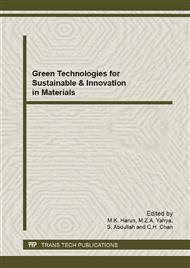[1]
B. Petrusevski and S. Sharma, Arsenic in Drinking Water, CW Delft, (2007).
Google Scholar
[2]
World Health Organization, Guidelines for Drinking-water Quality, Malta, ISBN 9789241548151, (2011).
Google Scholar
[3]
S. S. Gupta and K. G. Bhattacharyya, Immobilization of Pb(II), Cd(II) and Ni(II) Ions on Kaolinite and Montmorillonite Surfaces from Aqueous Medium, Journal of Environmental Management, pp.46-58, (2007).
DOI: 10.1016/j.jenvman.2007.01.048
Google Scholar
[4]
Y. Sun, Xi. Li, J. Cao, W. Zhang, and H. P. Wang, Characterization of Zero-valent Iron Nanoparticles, Advances in Colloid and Interface Science, pp.47-56, (2006).
DOI: 10.1016/j.cis.2006.03.001
Google Scholar
[5]
D. Mohan and C. U. Jr. Pittman, Arsenic Removal from Water/wastewater Using Adsorbents - A Critical Review, Journal of Hazardous Materials, pp.1-53, (2007).
DOI: 10.1016/j.jhazmat.2007.01.006
Google Scholar
[6]
G. Kim, W. Jeong, and S. Choe, Dechlorination of Atrazine Using Zero-valent Iron Under Neutral pH Conditions, Journal of Hazardous Materials, pp.502-506, (2008).
DOI: 10.1016/j.jhazmat.2007.11.092
Google Scholar
[7]
Y. H. Liou, S. Lo, Chin-Jung Lin, W. H. Kuan, and S. C. Weng, Chemical Reduction of an Unbuffered Nitrate Solution Using Catalyzed and Uncatalyzed Nanoscale Iron Particles, Journal of Hazardous Materials, pp.102-110, (2005).
DOI: 10.1016/j.jhazmat.2005.06.029
Google Scholar
[8]
M. B. Rodrigues, F. T. Silva, and T. C.B. Paiva, Combined Zero-valent Iron and Fenton Processes for the Treatment of Brazilian TNT Industry Wastewater, Journal of Hazardous Materials, pp.1224-1228, (2009).
DOI: 10.1016/j.jhazmat.2008.09.120
Google Scholar
[9]
C. Uzum et al., Application of Zero-valent Iron Nanoparticles for the Removal of Aqueous Co2+ Ions Under Various Experimental Conditions, Chemical Engineering Journal, pp.213-220, (2008).
DOI: 10.1016/j.cej.2008.01.024
Google Scholar
[10]
Y. Wu, J. Zhang, Y. Tong, and X. Xu, Chromium(VI) Reduction in Aqueous Solutions by Fe3O4-stablized Fe0 nanoparticles, Journal of Hazardous Materials, pp.1640-1645, (2009).
DOI: 10.1016/j.jhazmat.2009.08.045
Google Scholar
[11]
W. Zhang, Nanoscale Iron Particles for Environmental Remediation: An Overview, Journal of Nanoparticle Research 5, pp.323-332, (2003).
Google Scholar
[12]
D., Mishra, D., Chaudhury, G.R. Mohapatra and R.P. Das, Arsenic(V) Adsorption Mechanism Using Kaolinite, Montmorillonite and Illite from Aqueous Medium, Journal of Environmental Science and Health Part A, pp.463-469, (2007).
DOI: 10.1080/10934520601187666
Google Scholar
[13]
R. E. Grim, Clay Mineralogy. New York: McGraw-Hill Book Company Inc. , (1953).
Google Scholar
[14]
C. H. Zhou et al., Generation and Characterization of Catalytic Nanocomposite Materials of Highly Isolated Iron Nanoparticles Dispersed in Clays, Topics in Catalysis, pp.213-219, (2006).
DOI: 10.1007/s11244-006-0059-9
Google Scholar
[15]
C. Gu, H. Jia, H. Li, B. J. Teppen, and S. A. Boyd, Synthesis of Highly Reactive Subnano-sized Zero-valent Iron Using Smectite Clay Templates, Environmental Science Technology, pp. A-F, (2010).
DOI: 10.1021/es903801r
Google Scholar
[16]
D. Masih, Y. Izumi, K. Aika, and Y. Seida, Optimization of an Iron Intercalated Montmorillonite Preparation for the Removal of Arsenic at Low Concentrations, Engineering LIfe Science, vol. 7, no. 1, pp.52-60, November (2006).
DOI: 10.1002/elsc.200620171
Google Scholar
[17]
Y. Ho, Isotherms for the Sorption of Lead onto Peat: Comparison of Linear and Non-linear Methods, Polish Journal of Environmental Studies, pp.81-86, (2006).
Google Scholar
[18]
C. Gu, H. Jia, Hui Li, and B. J. Boyd, S. A. Teppen, Synthesis of Highly Reactive Subnano-sized Zero-valent Iron Using Smectite Clay Templates, Environmental Science Technology, pp. A-F, April (2010).
DOI: 10.1021/es903801r
Google Scholar
[19]
R. E Grim, Clay Mineralogy. New York, U.S. A: McGraw-Hill Book Company, Inc., (1953).
Google Scholar
[20]
D. H. Doff, N. H. J. Gangas, J. E. M. Allan, and J. M. D. Coey, Preparation and Characterization of Iron Pillared Montmorillonite, Clay Minerals, vol. 23, pp.367-377, July (1988).
DOI: 10.1180/claymin.1988.023.4.04
Google Scholar
[21]
P. Yuan, F. Annabi-Bergaya, Q. Tao, M, Fan, Z. Liu, J. Zhu, H. He, T. Chen., A Combined Study by XRD, FTIR, TG and HRTEM on the Structure of Delaminated Fe-intercalated/pillared Clay, Journal of Colloid and Interface Science, vol. 324, pp.142-149, May (2008).
DOI: 10.1016/j.jcis.2008.04.076
Google Scholar
[22]
B. Shrick, B. W. Hydutsky, J. L. Blough, and T. E. Mollouk, Delivery Vehicles for Zerovalent Metal Nanoparticles in Soil and Groundwater, Chemistry of Materials, vol. 16, pp.2187-2193, (2004).
DOI: 10.1021/cm0218108
Google Scholar
[23]
C. Jeon, K. Baek, J. Park, Y. Oh, and S. Lee, Adsorption Characteristics of As(V) on Iron-coated Zeolite, Journal of Hazardous Materials, vol. 163, pp.808-808, (2009).
DOI: 10.1016/j.jhazmat.2008.07.052
Google Scholar
[24]
A. Ramesh, H. Hasegawa, T. Maki, and K. Ueda, Adsorption of Inorganic and Organic Arsenic from Aqueous Solutions by Polymeric Al/Fe Modified Montmorillonite, Separation and Purification Technology, vol. 56, pp.90-100, (2007).
DOI: 10.1016/j.seppur.2007.01.025
Google Scholar
[25]
C. W Cheung, J. F. Porter, and G. McKay, Sorption Kinetic Analysis for the Removal of Cadmium Ions from Effluents Using Bone Char, Water Research, vol. 35, no. 3, pp.605-612, June (2001).
DOI: 10.1016/s0043-1354(00)00306-7
Google Scholar
[26]
R. C. Bansal and Goyal M, Activated Carbon Adsorption. New York, U.S.A.: CRC Press, (2005).
Google Scholar
[27]
K. Y. Foo and B. H. Hameed, Insights into the Modeling of Adsorption Isotherm Systems, Chemical Engineerng Journal, vol. 156, pp.2-10, (2010).
Google Scholar


